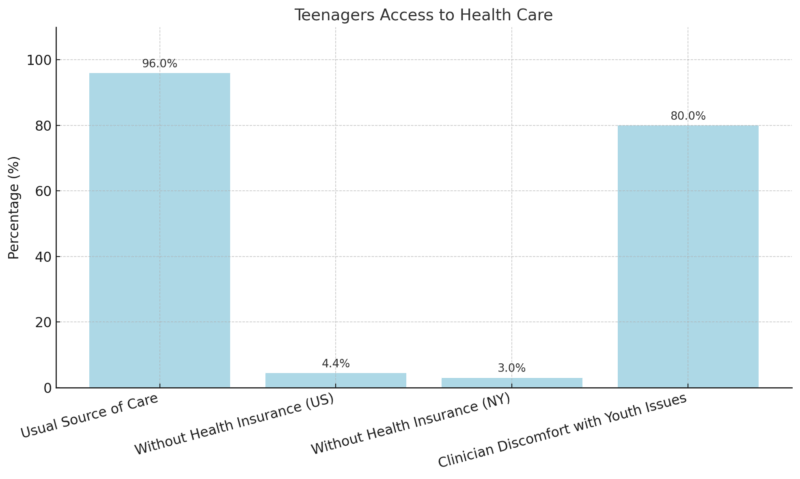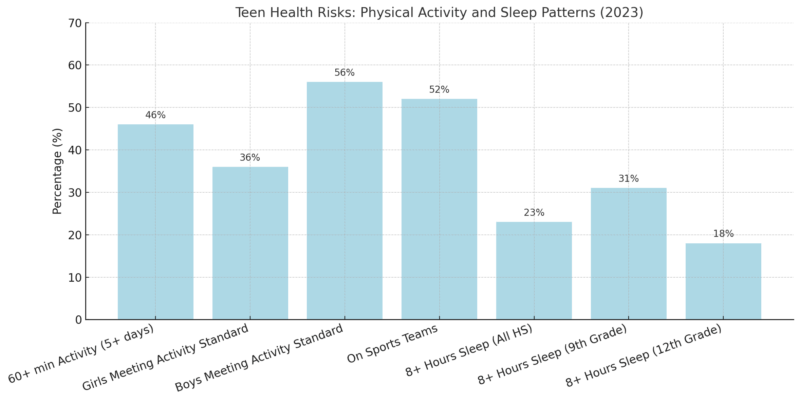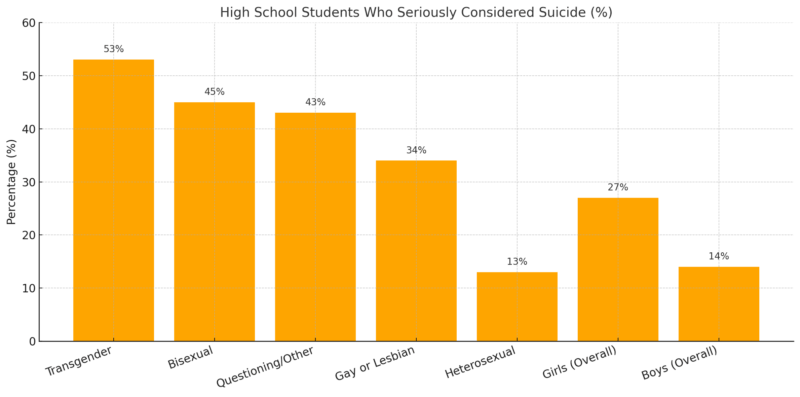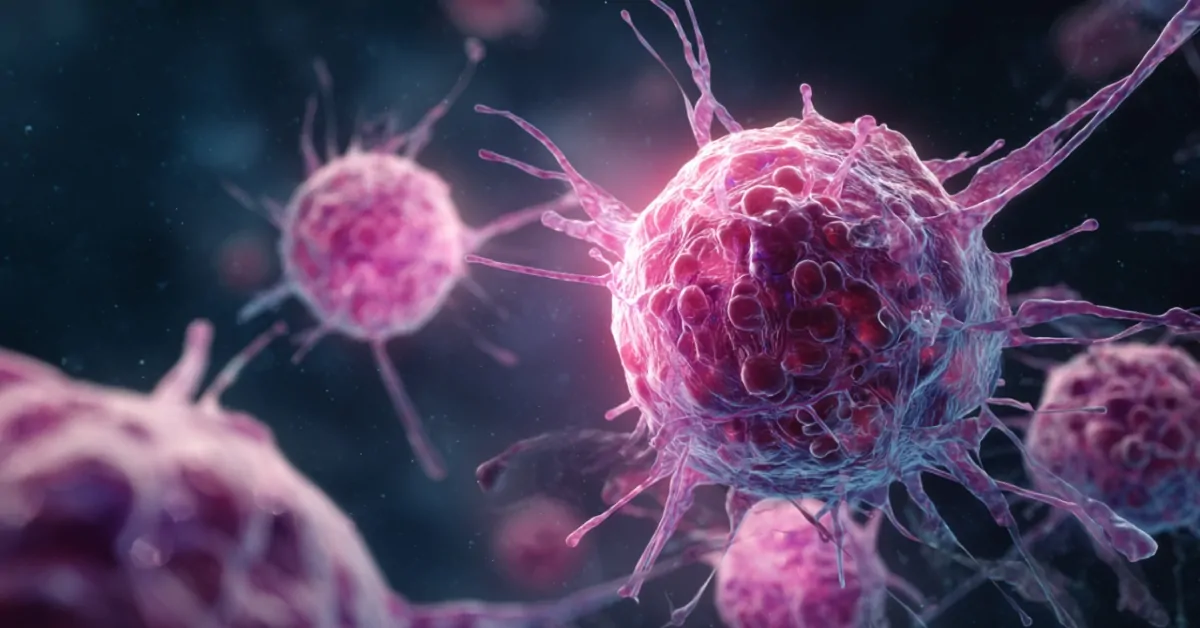Teenagers in the United States face a unique combination of health risks shaped by physical development, social pressures, environmental disparities, and uneven access to care.
According to the CDC and the National Center for Health Statistics, nearly one in five adolescents (ages 12 to 17) will experience a major depressive episode each year, yet more than half receive no treatment.
Meanwhile, 22.2% of teens are obese, and fewer than one in four get the recommended amount of sleep on school nights. These health challenges intersect with rising rates of suicide, dating violence, and substance use among specific demographic groups.
Table of Contents
Toggle1. Access to Health Care

Though the majority of American teens have access to some form of medical care, disparities still exist, especially by income and race/ethnicity.
Confidentiality is a key issue. Many teens avoid seeking care (particularly for reproductive or mental health) because they fear their privacy will not be protected.
Dental care also shows disparities: 88% of adolescents visited a dentist in 2020, but private insurance greatly increases the odds of receiving care.
2. Diet, Obesity, and Disordered Eating
Teen nutrition is a growing public health concern, especially with the rising prevalence of obesity and disordered eating.

Nutrition in adolescence affects not only physical growth but also cognitive development, academic performance, and lifelong health behaviors.
- Food insecurity: USDA data shows 18% of households with children were food insecure at some point in 2022. That means nearly one in five families couldn’t always afford enough nutritious food.
- Racial disparities in obesity:
- Non-Hispanic Black adolescents: 24% obesity rate
- Hispanic adolescents: 26%
- Non-Hispanic White adolescents: 17%
- Asian adolescents: 9%
(Source: NHANES, 2022)
- Disordered eating: A 2023 meta-analysis published in JAMA Pediatrics found that up to 22% of adolescents worldwide engage in behaviors such as skipping meals, purging, or binge eating, many without meeting full diagnostic criteria for eating disorders.
- Body image and social media: A 2022 study in the Journal of Adolescent Health linked daily Instagram use with a three times higher likelihood of teens reporting body dissatisfaction.
3. Physical Activity and Sleep
Physical health habits during the teen years shape long-term well-being, yet many adolescents fall short of recommended activity and sleep guidelines.

Physical activity and sleep play a critical role in shaping adolescent health, but many U.S. teens are falling behind in both areas. The CDC advises that children and teens aged 6 to 17 should get at least 60 minutes of moderate-to-vigorous physical activity each day, yet only about 24% meet this standard.
Regular activity not only supports physical health but also correlates strongly with academic success; physically active students tend to have higher GPAs, better focus, and improved classroom behavior. One 2021 study found a 15% academic performance boost among active teens compared to their inactive peers.
Gender differences are a major factor in these trends. Boys are significantly more likely than girls to meet daily activity goals. Girls often cite social stigma, concerns about safety, and body image pressure as key reasons for not engaging in regular physical activity. These patterns may widen long-term health disparities between genders if not addressed early.
Sleep is another area of concern. Only 23% of high school students report getting at least eight hours of sleep on school nights. This shortfall has wide-ranging effects: teens who don’t get enough sleep are at greater risk for depression, impaired learning, weakened immune response, and even metabolic disorders.
According to the American Academy of Pediatrics, shifting school start times later aligns better with adolescent biological clocks and leads to improved attendance, better grades, and fewer emotional health issues. Despite this evidence, many school districts have yet to implement these changes.
Scoliosis, a spinal curvature disorder that typically emerges during adolescence, can also interfere with physical activity levels, especially for girls, who are more commonly affected. According to treatingscoliosis.com, scoliosis is diagnosed in approximately 2% to 3% of adolescents, often during school-based screenings.
Most cases are mild and manageable with physical therapy or monitoring, moderate to severe cases may cause pain, reduced mobility, and emotional distress during key developmental years. If untreated, scoliosis can limit participation in sports or physical education and may also contribute to body image issues, further discouraging activity.
For students diagnosed early and managed properly, however, many can stay active without major limitations, emphasizing the importance of routine screening and inclusive fitness opportunities.
Together, poor sleep and insufficient physical activity create a feedback loop that worsens stress, academic problems, and mental health struggles. Addressing both areas with systemic support, from better scheduling to safer, more inclusive physical activity options, is essential to improving teen health outcomes.
4. Mental Health
Adolescent mental health in the U.S. is in crisis. Anxiety, depression, and suicidal thoughts are affecting millions of teens, with stark disparities based on gender, sexual orientation, and identity.
Condition
Prevalence (2023)
Girls (12 to 17) diagnosed with anxiety
20%
Boys (12 to 17) diagnosed with anxiety
12%
Girls diagnosed with depression
11%
Boys diagnosed with depression
6%
Major depressive episodes (12–17)
One in five teens
Teens who received no treatment
~3 million
Among high school students:

Suicide is now one of the top three causes of death for teens. From 2000 to 2021, the suicide rate for youth ages 10 to 24 rose by 52%.
5. Substance Use and Abuse
Substance use continues to pose serious threats to adolescent health. While traditional cigarette use is declining, alcohol, marijuana, and vaping are widespread.
Substance
Teen Use (12 to 17)
Cigarettes (past month)
2.3%
Alcohol (past month)
9.4%
Any illicit drug use (lifetime by grade 12)
~50%
High school seniors who tried alcohol
63.2%
Seniors who tried tobacco
~66%
Adolescents are experimenting with substances at younger ages, and newer drug forms increase the risk of harm and addiction.
- Alcohol: Nearly one in 10 teens aged 12 to 17 reported drinking in the past month (NSDUH, 2022).
- Binge drinking is more common among older teens, especially in social settings like parties.
- Vaping:
- Over 14% of high schoolers used e-cigarettes in the past 30 days.
- Many are unaware that popular products like JUUL contain nicotine equivalent to an entire pack of cigarettes per pod.
- Marijuana use:
- Legalization has led to increased perception of safety.
- 35% of high school seniors report using marijuana in the past year.
- Studies show heavy use may impair IQ, memory, and decision-making during adolescence.
- Fentanyl risk: Illicit fentanyl-laced pills have led to a rise in accidental overdoses among teens, with cases often involving fake “Percocet” or “Xanax” bought online.
FENTANYL DEATHS: Even among adolescents & young children; “Across age groups, annual deaths peaked in 2020 and 2021, suggesting that the COVID-19 pandemic exacerbated this public health crisis.” Young much less risk of COVID but susceptible to disruptionhttps://t.co/8DfTh6skE1
— Monica Gandhi MD, MPH (@MonicaGandhi9) May 13, 2023
6. Sexual Health and Dating Violence
Teen sexual activity has declined over the decades, but risk remains, especially for certain groups.

Teens identifying as LGBTQ+ are disproportionately at risk of sexual violence and STIs. Meanwhile, teen pregnancy rates are at historic lows, partly due to improved contraception use and delayed sexual debut.
Dating violence is another concern. Among teens who dated:

7. Injury, Violence, and Teen Mortality
Accidents, violence, and suicide are the three leading causes of death among teens.

Other violence trends:
Issue
Teen Statistic
Physical fights (2023)
19% (down from 36% in 2007)
Carried weapon on school grounds (past 30 days)
4%
Threatened or injured by a weapon on school grounds
9%
Gun possession by males (past 12 months)
5%
Injury, violence, and mortality also remain top concerns for teens, particularly those in the 15 to 19 age group. Accidents are the leading cause of death (especially motor vehicle crashes), responsible for nearly 38% of fatalities among adolescents.
Homicide is the second leading cause at 21%, followed closely by suicide at 18%. These causes account for the majority of teen deaths and highlight the risks that extend beyond health behaviors into safety, mental health, and exposure to violence.
Motor vehicle crashes continue to claim the lives of thousands of teens each year. Inexperience, distracted driving, and low seatbelt use contribute to the high fatality rate among adolescent drivers. Males are at especially high risk, with significantly higher rates of both fatal accidents and overall mortality than females in the same age group.
School violence and personal safety remain critical issues as well. In 2023, 9% of students reported being threatened or injured with a weapon on school property, while 4% admitted to carrying a weapon to school at least once in the prior 30 days.
Among male teens, nearly 5% reported carrying a gun at some point in the past year. These figures point to a need for continued efforts in school safety, conflict resolution education, and mental health support.
Youth incarceration has declined by 75% since 2000, with fewer than 28,000 adolescents held in detention on a typical day in 2022. Still, significant racial disparities persist within the justice system.
Black teens are more than five times as likely as White teens to be incarcerated, despite similar offense rates, according to The Sentencing Project. These disparities reflect broader social inequities and require comprehensive reform.
Teen dating violence is another form of harm that affects thousands of youth annually. Among students who date, 10% of girls and 7% of boys report experiencing physical harm; being hit, slammed, or otherwise hurt by a partner. LGBTQ+ students again report higher rates of abuse.
For example, 21% of bisexual youth who dated reported experiencing sexual dating violence, compared to just 7% of heterosexual peers. Although the overall prevalence of dating violence has declined since 2013, it remains a deeply rooted issue that demands continued attention in both policy and education.
Final Thoughts
The leading health concerns for American teens are no longer just about catching colds or passing sports physicals. Mental illness, trauma, violence, obesity, and systemic inequity dominate the landscape.
While access to general care is relatively high, real gaps remain in mental health, reproductive privacy, violence prevention, and substance education. To make meaningful change, communities must:
The health of America’s teenagers is a mirror to the nation’s systems. And right now, that mirror reflects both progress and an urgent call to act.
Endnote
Teenagers today are navigating more than just growing pains; they’re confronting a complex mix of mental, physical, and social health challenges in a world that often moves too fast for their needs to be fully seen or met.
The data make it clear: a rising number of teens are struggling with anxiety, sleep deprivation, substance use, body image pressure, and trauma, all while facing uneven access to support systems that should be there for them.
This isn’t about blaming young people for poor habits or overlooking progress in teen pregnancy prevention or tobacco use. It’s about recognizing the real-world pressures they face, from overpacked school schedules and social media scrutiny to unequal access to health care or culturally sensitive mental health support.
These aren’t isolated problems; they’re part of a bigger picture that demands coordinated attention.
Supporting teen health means meeting them where they are, listening without judgment, offering care that protects their privacy, and creating environments (school, at home, online) that promote connection instead of isolation.
It also means acknowledging that the most vulnerable teens, those in rural areas, LGBTQ+ youth, Black and Hispanic adolescents, and those living in poverty often face the biggest gaps in care and support.








